A Private Tour today in North Norfolk, a day of relaxed birding for beginners. Even though it wasn’t exactly tropical, the weather was kind with much lighter winds and even some sunshine at times.
We made our way along the coast to Titchwell first. Before it got too busy, we had a look around the overflow car park. Once again, there were lots of finches in the brambles – mainly Chaffinches and Greenfinches. But as we walked past the toilet block we could hear the delicate, mournful piping of Bullfinches and two flew over the road ahead of us and up into the top of the hedge, flashing their square white rumps. We could hear more in the brambles and walked quietly round to where we could see, but the Bullfinches were nervous today and flew up into the trees before we could get them in the scope. There were at least four, including two smart pink males. A Song Thrush feeding in the leaf litter down below was more obliging.
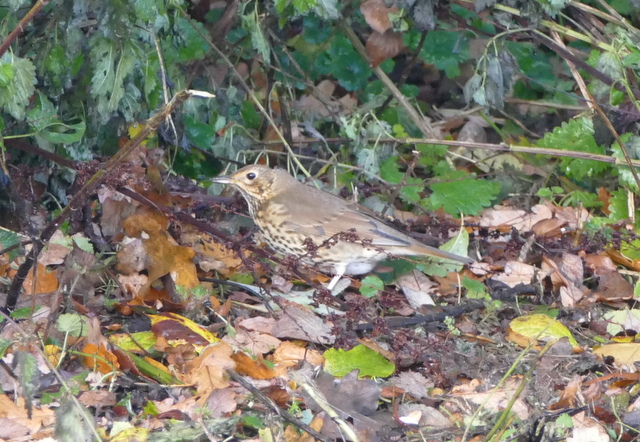 Song Thrush – feeding in the leaves in the overflow car park at Titchwell
Song Thrush – feeding in the leaves in the overflow car park at Titchwell
Walking through the trees to the visitor centre, we came across a mixed flock of Long-tailed Tits and other tits going the other way. A Great Spotted Woodpecker flew away through the trees and landed briefly on a trunk. Round at the feeders, several Coal Tits kept darting in, grabbing a seed and darting back to the safety of the trees. A plainer pale brown bodied tit with a black cap and white face was doing the same thing, a Marsh Tit, though it was hard to follow it at times as in came in and out so quickly.
We spent some time looking at the finches on the feeders as well. There were plenty of Chaffinches, the colourful males with rusty-red underparts and grey caps, and the browner females. A few Greenfinches joined them. There were lots of Goldfinches in the alder trees above but three at least flew down to the feeders. We could hear Siskins calling, but couldn’t see any in the trees here. That’s because they were all in the alders along the start of the main footpath and we stopped there to admire them. A smart green, yellow and black male Siskin perched right in front of us for some time, picking at the alder cones.
 Siskin – this male perched for some time in front of us
Siskin – this male perched for some time in front of us
There were lots of birds on the move today. As we started out onto the reserve, a Grey Wagtail flew west over our heads calling. We had heard a couple of flocks of Redwings over the trees by the visitor centre and another flew over and out across the grazing meadow towards Thornham. Further along, their loud ‘chack-chack-chack’ calls alerted us to a long line of Fieldfares above our heads, flying west.
But the real star movers of the day were the Starlings. Flock after flock, many 100s of birds strong, came past us or over us. One estimate suggested that as many as 14,000 Starlings flew over Titchwell this morning, and we could certainly believe it. The birds are coming in for the winter from Northern Europe and, once they make it in over the sea and hit the coast, they seem to funnel westwards.
The drained grazing meadow pool looked quiet at first, but a couple of waders were over on the largest puddle at the back. Through the scope we could see they both had orangey-red legs. One was, as might be expected, a Redshank; the other was a winter adult Ruff, a common confusion species at this time of year. It was a great opportunity to study them side-by-side – noting in particular the plainer, darker grey back of the Redshank and more scalloped upperparts of the Ruff, with contrasting pale edges to its feathers.
Our next stop was Island Hide. The water levels on the freshmarsh are being raised for the winter, but there were still lots of ducks and gulls to look through, and a fair selection of waders.
 Avocets – a small party are hanging on, despite the colder weather
Avocets – a small party are hanging on, despite the colder weather
Most of the Avocets have gone south for the winter, but a small number continue to cling on here, despite the colder weather. A line of about a dozen were asleep over towards the back of the freshmarsh. A flock of Black-tailed Godwits flew in to join them. Lapwings are always striking, with their green backs, black and white faces and spiky crests. As well as a few on the freshmarsh, we saw several flocks on the move, flying west today. Amongst the little parties of Dunlin was a single Ringed Plover. A Common Snipe were struggling to look camouflaged on a small island with little vegetation.
There are lots of ducks in for the winter now. The largest number out on the freshmarsh were Teal, mostly sleeping or feeding around the islands. There were plenty of Gadwall and Mallard too, the numbers of the resident birds swollen with migrants from the continent. Amongs them we found a few sleeping Shoveler. Most of the Wigeon were on the islands over towards the back, but a pair were with the other ducks much closer, giving us a better view of the drake with the creamy yellow stripe up over his forehead. The Brent Geese kept dropping in for bathe and preen and then flying back out again to feed on the saltmarsh beyond.
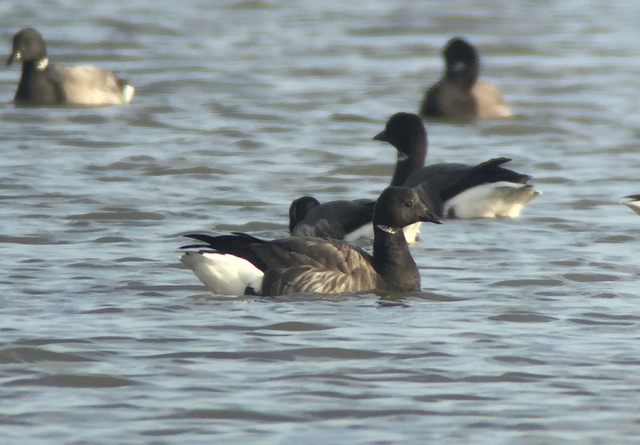 Brent Geese – come into the freshmarsh to bathe and preen
Brent Geese – come into the freshmarsh to bathe and preen
We were mostly looking the other way, but some squealing behind us alerted us to a Water Rail flying across in front of the reeds. Unfortunately, it disappeared straight in out of sight, but a second Water Rail then worked its way in and out along the front edge of the reeds.
Back up on the main footpath, we were told of some Shorelark out on Thornham Point. We had intended to have a look in at the Parrinder Hide, but with the sun shining through the hazy clouds we decided to carry straight on towards the beach first. We scanned the marshes and pools as we went.
The Volunteer Marsh was rather quiet today, apart from a few Redshank and Curlew and a lot of Shelduck. There was more activity around the tidal pools. Three Spotted Redshanks were up to their bellies in water, feeding feverishly. A Common Redshank next to them was great to compare – the Spotted Redshanks being much paler/whiter, with a longer, finer bill. The Avocet out here was awake and feeding, in and out between a couple of female Pintail. A Black-tailed Godwit right by the path was sporting a set of individually colour-coded rings which can be used to identify where it has been seen previously.
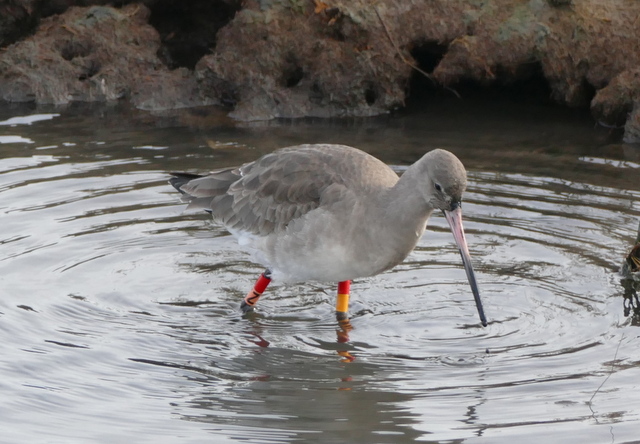 Black-tailed Godwit – sporting a set of colour rings
Black-tailed Godwit – sporting a set of colour rings
The tide was out when we got to the beach, so we walked out across the sand to get a better look at the waders down around the rocks. Several silvery grey and white Sanderling were running around on the beach like clockwork toys. The much darker Turnstones picking around the seaweed are much more measured in their gait. There were lots of Oystercatchers out on the sand too. Around the rocks, we could see several Bar-tailed Godwits, paler and streakier backed than their Black-tailed cousins, and small groups of dumpy grey Knot.
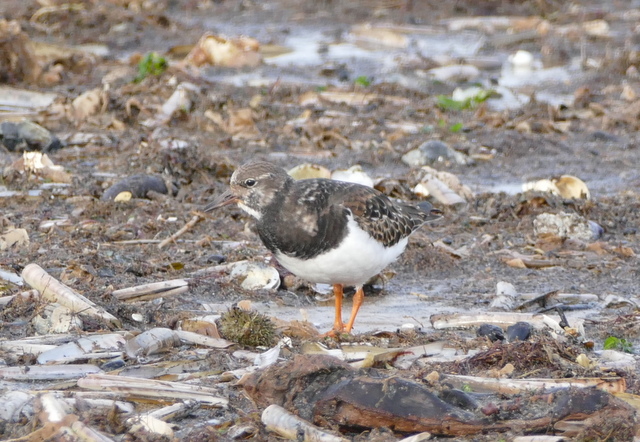 Turnstone – one of many down on the beach
Turnstone – one of many down on the beach
We decided to walk west along the beach to Thornham Point. The sand was littered with shells – razor clams, cockles, mussels, whelks, clams and more. The storms of the last few days have washed huge quantities up onto the beach and there were loads of birds enjoying the bounty, mostly gulls of various shapes and sizes, but many of the waders as well. We had hoped to catch up with the Shorelarks, but they had flown off by the time we got there.A quick search of the point produced a pair of Stonechats in the bushes.
As we started to make our way back, three Snow Buntings flew overhead, attempting to land on the edge of the dunes before realising there were too many people and disappearing off towards Brancaster. A little while later, six Snow Buntings came back the other way along the shoreline.
A couple of trawlers were fishing offshore, with a huge flock of gulls following in their wake. In with them were a couple of Gannets, a mostly white adult and a slaty juvenile. Four Red-breasted Mergansers were on the sea close inshore and a couple of Goldeneye were also, a bit further along.
Scanning out to sea, we picked up several lines of Starlings coming in over the water, as well as seeing a few flocks flying west over the beach. A single Grey Heron was also seen flying in over the sea, another bird presumably escaping the approaching winter on the continent. Even when it is cold here, we should remember it is generally much colder still in northern Europe through the winter.
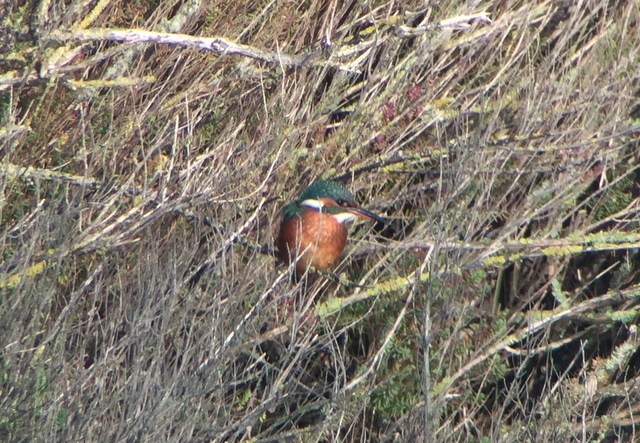 Kingfisher – feeding around the edge of the tidal pools
Kingfisher – feeding around the edge of the tidal pools
We were starting to make our way back from the beach when we noticed a small bird perched in the bushes overhanging the edge of the tidal pools. Even silhouetted against the sun we could tell what it was, a Kingfisher. It flew a short distance further along, perched, hovered over the water and dived in, then flew along further still. It was only when we walked down the main path past it and looked back that we could really see its colouration, especially when it flew across over the water to the other side flashing bright blue as it went.
It was getting late by this stage, so we made our way back to the car, pausing briefly to admire an Avocet feeding up to its belly in the deep channel on the Volunteer Marsh alongside the footpath. A couple of Goldcrests were feeding in the bushes in the car park while we enjoyed a late lunch.
 Avocet – feeding in the deep channel on the Volunteer Marsh
Avocet – feeding in the deep channel on the Volunteer Marsh
After lunch, we made our way back along the coast road. It was a lovely bright afternoon, so perhaps it was not a surprise to see a few Barn Owls out feeding in the meadows, particularly after a succession of wet and windy nights. One in particular was flying back and forth right by the road and, when we stopped to admire it, we noticed a second Barn Owl further back in the same field.
We stopped by the main road at Holkham for a scan of the freshmarsh below. There were lots of small groups of Pink-footed Geese flying back and forth. Down in the wet grassy field, among the bigger flocks of Greylag Geese, we picked out several small groups of White-fronted Geese. Smaller and darker than the Greylags, the adult Whitefronts have distinctive white surrounding the base of their bills and variable black belly bars. There were also a couple of Canada Geese and a pair of Egyptian Geese to add to the variety. Nearby, the very pale, white-breasted Common Buzzard was perched in one of its usual trees.
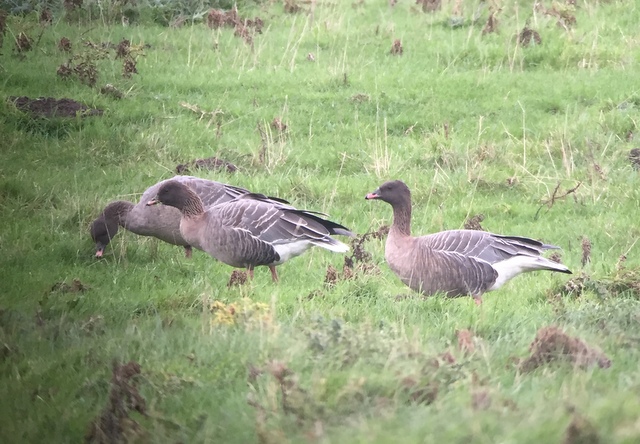 Pink-footed Geese – a few were feeding along Lady Anne’s Drive
Pink-footed Geese – a few were feeding along Lady Anne’s Drive
Down at Lady Anne’s Drive, we stopped again to have a good look at the Pink-footed Geese. There were several small groups feeding in the fields by the road. Over the other side, on the edge of the field near the hedge, a little covey of four Grey Partridge were feeding quietly.
We had planned to walk along to Washington Hide to watch the Pink-footed Geese arriving to roost. Whilst a few may be here all day, most of the birds fly inland to feed and return here in the evening. However, we were still standing on Lady Anne’s Drive when we heard a loud cacophony of geese approaching and several thousand geese flew in from the west and dropped down onto the fields. It was quite a sight.
 Pink-footed Geese – thousands of birds coming in to roost
Pink-footed Geese – thousands of birds coming in to roost
Still, we made our way west along the path on the edge of the pines, pausing briefly to admire the Little Grebes on Salts Hole. From Washington Hide, we could see the huge flocks of Pink-footed Geese out in the grass towards the back. Some smaller flocks were closer, and in with them we found a Barnacle Goose – unfortunately a feral bird accompanied by an odd hybrid.
As we sat in Washington Hide, a couple more huge skeins of Pink-footed Geese flew in and dropped down to join the others already there. Several Marsh Harriers were circling over the reeds in front of the hide, waiting to go to roost. It had clouded over by this stage and the light was starting to go, so we decided to make our way back to the car and call it a day.
















